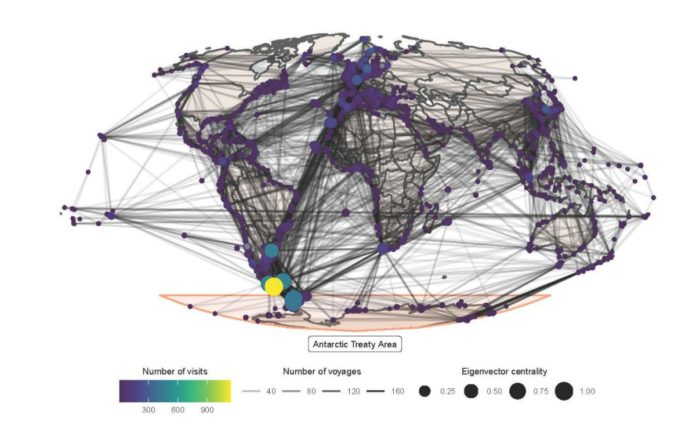Antarctica’s pristine ecology is threatened by invasive, non-native species brought in by fishing, tourism, research, and supply ships.
The University of Cambridge and the British Antarctic Survey have conducted a new study in which they tracked the global movements of all ships that visit Antarctic waters. It indicates that Antarctica is linked to the rest of the world through a vast network of ship traffic.
The team found 1,581 ports connected to Antarctica, all of which might be a possible source of non-native species. Mussels, barnacles, crabs, and algae attach themselves to the hulls of ships in a process known as ‘biofouling.’ The discovery shows that they might travel from any part of the world to Antarctic waters.
“Invasive, non-native species are one of the biggest threats to Antarctica’s biodiversity. Its native species have been isolated for the last 15-30 million years,” says said Professor David Aldridge, senior author of the report, adding, “They may also have economic impacts, via the disruption of fisheries.”
Scientists are particularly concerned about the spread of organisms from pole to pole. These species are already accustomed to the cold and may make the journey on tourist or research ships that spend the summer in the Arctic before crossing the Atlantic to spend the summer in Antarctica.
“The species that grow on the hull of a ship are determined by where it has been. We found that fishing boats operating in Antarctic waters visit quite a restricted network of ports, but the tourist and supply ships travel across the world,” said Arlie McCarthy, first author of the report.
They discovered that research vessels stayed in Antarctic ports for longer periods of time than tourism vessels. Fishing and supply ships, on average, stay for considerably longer. Longer stays, according to a previous study, increase the chances of non-native species being introduced.
Many groups of organisms have not evolved the ability to tolerate Antarctic wildlife due to its remote, isolated position. Mussels, for example, may grow on ship hulls and have no natural predators in Antarctica, so if they are accidently introduced, they will have no competition. Shallow-water crabs would introduce a new type of predatory behavior to Antarctic creatures that they have never seen before.
“We were surprised to find that Antarctica is much more globally connected than was previously thought. Our results show that biosecurity measures need to be implemented at a wider range of locations than they currently are,” says McCarthy.
She adds: “There are strict regulations in place for preventing non-native species getting into Antarctica, but the success of these relies on having the information to inform management decisions. We hope our findings will improve the ability to detect invasive species before they become a problem.”
From 2014 to 2018, the study analyzed verified port call data alongside raw satellite observations of ship activity south of -60° latitude. Vessels were found to cruise between Antarctica and locations in southern South America, Northern Europe, and the western Pacific Ocean most regularly.
The Southern Ocean, which surrounds Antarctica, is the world’s most isolated marine habitat. It maintains a diverse range of plant and animal life and is the only known invasive species-free maritime zone on the planet. The threat of non-native species being accidentally introduced to this region is increasing due to increased ship activity in this area.
Invasive organisms coming on ships might also impact large krill fisheries in the southern waters. Krill is a common ingredient in fish feed for the worldwide aquaculture sector, and krill oil is widely available as a dietary supplement.
“Biosecurity measures to protect Antarctica, such as cleaning ships’ hulls, are currently focused on a small group of recognised ‘gateway ports’. With these new findings, we call for improved biosecurity protocols and environmental protection measures to protect Antarctic waters from non-native species, particularly as ocean temperatures continue to rise due to climate change,” said Professor Lloyd Peck, a researcher at the British Antarctic Survey, who was also involved in the study.
Source: 10.1073/pnas.2110303118
You were reading: Invasive species can reach Antarctica from more than 1,500 ports
